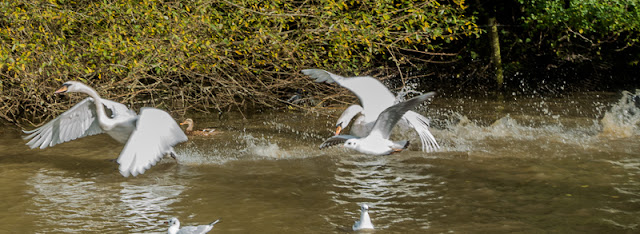The autumn brightness this morning (forecast to cloud over and rain after lunch) was too good to waste. I walked round Abbey Fields and was much taken by the behaviour of the waterfowl on the lake. These included five adult swans and four of this year's cygnets. A pair of the adults, bigger than the other three, must have been the parents of the cygnets. They were dominant and aggressive and constantly harried the younger non-breeding adults, likely in their first adult year. Whenever any of the younger adults settled to feed or preen, or happened to go near the cygnets, one or both of the parents would chase them off. I have never seen swans swimming so fast - they were charging the younger birds, much as a mammal on four legs might run at a subordinate animal. The swimming charge would precede a take-off, flying at the younger bird. I assume that this was breeding territoriality. The conspicuous aggression also had the effect of triggering aggression between other birds: mallards harried each other; little gulls (we have a permanently resident inland population on the lake) chased each other in the air; coots chased each other in the water; and one moorhen jumped onto the neck of another, holding it under the water, appearing to be trying to drown it . . . the victim managed to escape.
Monday, 1 November 2021
A bright November morning (1) - aggressive swans
The parent pair - this wing ruffling is the prelude to active aggression.
One parent and their four cygnets.
The other parent starts to harry one of the young adults.
And the fast swimming becomes a take-off.
. . . here is the chase!
Another case of aggression - unwise of the little dog!
And unprovoked, one of the parents, starts to harry one of the juveniles again.
Subscribe to:
Post Comments (Atom)







No comments:
Post a Comment